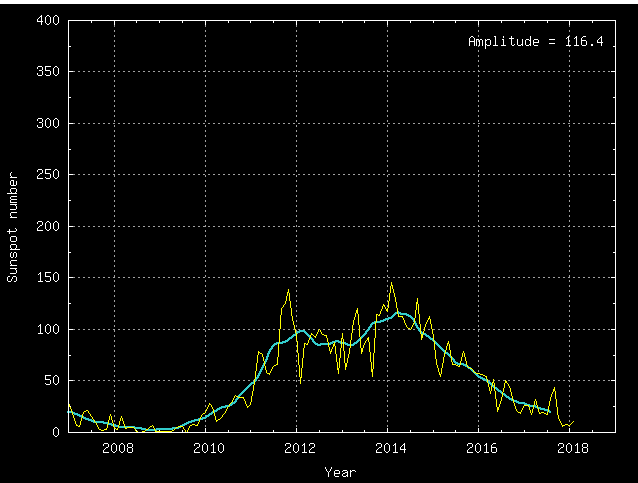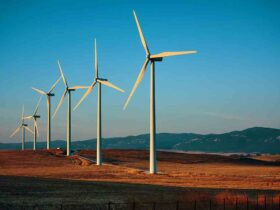Without a doubt climate has been and is always changing. However, is it possible that we will not in fact be plagued with rising temperatures but falling temperatures. Instead of global warming are we in for a new ice age?
You Are Either A Contrarian Or A Victim
I am a contrarian thinker and investor. That means that I am constantly challenging the general consensus view. I start every analysis with the supposition that the general public has normally got it wrong on whatever subject is at hand. What if the current worrying about a warming earth is wrong and in fact we are heading for another little ice age?
Contrarian thinking has served me well in my investing career. I have seen time and again where the public lets its emotions, group-think, and ingested propaganda dominate its opinion. One of the best books written on the subject of contrary thinking is “The Art of Contrary Thinking” by Humphrey Neil.
I think the book is so important I did a video review of it which can be viewed at this link.
In the book Mr. Neil makes three statements as it relates to contrarian thinking;
First, as mentioned, I learned that individual opinions (my own as well as the next man’s) are of little value—because they are so frequently wrong.
Second, that human traits (of fear, hope, greed, pride-of-opinion, wishful thinking) are so strong in the human breast that they prevent one from being objective. Objective analysis of economic trends is imperative, I believe, as subjective reasoning leads to opinionated conclusions.
Third, that if one relies stubbornly on his own opinion he is likely to “stand on his opinion,” right or wrong. No trait is stronger, perhaps, than that of defending one’s opinion and of being unwilling to admit error in judgment.
Mr. Neil goes onto to say the following:
If individual opinions are unreliable, why not go opposite to crowd opinion—that is, contrary to general opinions which are so often wrong?
Not By Fire But By Ice
One of the biggest ideas that has permeated the west over the last couple of decades is the notion that CO2 that is emitted from the burning of hydrocarbons is causing earth’s climate to change. This idea started out as global warming. When the temperatures in fact did not rise as greatly, as the scientific models had predicted, proponents of this theory cleverly re-marketed the idea as “climate change” and blamed every weather anomaly as being caused by human activity.
But as I was taught in high school and college, the climate has always changed and is always changing. Of that there is no doubt as even recent history proves.
How Did The Vikings Thrive In Greenland?
For example, do you know why the Vikings named Greenland well Greenland? Because it used to be warmer and it was green due to all the vegetation. They settled and farmed there for over 400 years, from 1000 to 1400 A.D, until the climate changed and it became cold again. The Norse were farmers and were not able to adapt to the changing climate.
As the Little Ice Age began to be felt it became more difficult for the Norse to maintain their farms. The ability to raise sufficient grains and provide fodder for farm animals eventually forced the Norse into a sea-based diet of seal and whale meat. At some point this became untenable and they were forced to leave their settlements or succumbed to hunger.
I think this video on “The Lost Vikings” is very informative and possibly prophetic of what awaits us in the near future.
Get Ready For Colder Tempratures
I believe, and the data is clearly indicating, that the earth is not warming to the extent that the consensus believes. In fact, I believe that we are leaving a period of warming and entering a period of cooling on earth.
This little known and not widely reported story has recently rekindled my interest in studying the sun, its cycles, and its effects on earths climate.
A recent article at RealClearMarkets drove me to writing this article. This important information was only reported there and at Investors Business Daily. The gist of the piece was that the earth just experienced the biggest two year cooling event in a century.
Would it surprise you to learn the greatest global two-year cooling event of the last century just occurred? From February 2016 to February 2018 (the latest month available) global average temperatures dropped 0.56°C. You have to go back to 1982-84 for the next biggest two-year drop, 0.47°C—also during the global warming era.
The author of the quoted article is quick to point out that this recent cooling is a statistical anomaly and that it cannot and does not discount the warming trend we have been seeing for decades. I agree, but if the climate is beginning to cool it has to begin sometime.
What Is The Sunspot Cycle And Why Should I Care?
I am a big fan of Don Coxe. He is a historian by training and became an institutional money manager in Canada where he ran money and advised other money managers for forty years. You can read his biography here. He used to do a weekly call for customers of BMO Capital around ten years ago. I was fortunate to be able to sneak onto the calls.
One of the things Mr. Coxe would talk about every so often on the calls was the sunspot cycle and its effects on agriculture and crop production. He seemed to have an interest in following this and thought it important enough to mention on several occasions.
Because I was an amateur radio operator I was familiar with the sunspot cycle and its affects on shortwave radio transmissions. After listening to Mr. Coxe my interest in climate change cause and effects was causing me to question the official narrative of CO2 as the primary driver of “global warming” or “climate change.” I never understood how the sun, which is the earths life giver, could be ignored as the most likely driver of climate on earth.
The cynical side of me understands that people who would be inclined to take advantage of a situation (remember let no crisis go to waste) would rather be able to point to CO2 as the cause of warming than the sun. CO2 emissions could presumably be controlled and taxed via regulation. I do not know any politician bold enough to say they can control the sun. There is power and profit in controlling CO2 emissions not so much in regulating the sun.
As a contrarian I am looking to challenge the prevailing zeitgeist. Are the facts that are present supporting the conclusions that the crowd has reached? This is an important question to ask because the crowd, as history has shown multiple times, is more often wrong than right. This is especially true at turning points in trends.
Do Less Sunspots=Lower Temps?
A recent article in Astronomy Now has also made me take another look at what could be one of the biggest contrarian opportunities of all time.
The name of the article is “Diminishing solar activity may bring new Ice Age by 2030”. Some excerpts from the article are very thought provoking;
The arrival of intense cold similar to the one that raged during the “Little Ice Age”, which froze the world during the 17th century and in the beginning of the 18th century, is expected in the years 2030—2040. These conclusions were presented by Professor V. Zharkova (Northumbria University) during the National Astronomy Meeting in Llandudno in Wales by the international group of scientists, which also includes Dr Helen Popova of the Skobeltsyn Institute of Nuclear Physics and of the Faculty of Physics of the Lomonosov Moscow State University, Professor Simon Shepherd of Bradford University and Dr Sergei Zharkov of Hull University.
(skip)
There are several cycles with different periods and properties, while the 11-year cycle, the 90-year cycle are the best known of them. The 11-year cycle appears as a cyclical reduction in stains on the surface of the Sun every 11 years. Its 90-year variation is associated with periodic reduction in the number of spots in the 11-year cycle in the 50-25%. In 17th century, though, there was a prolonged reduction in solar activity called the Maunder minimum, which lasted roughly from 1645 to 1700. During this period, there were only about 50 sunspots instead of the usual 40-50 thousand sunspots. Analysis of solar radiation showed that its maxima and minima almost coincide with the maxima and minima in the number of spots.
I found the last sentence very interesting. There appears to be a direct correlation between solar radiation and the number of sunspots. This is interesting because as was pointed out earlier in this article we have just experienced two of the coldest years in the last century. In addition, the article reported the following:
The authors extended the prediction of these two magnetic waves to the next two cycle 25 and 26 and discovered that the waves become fully separated into the opposite hemispheres in cycle 26 and thus have little chance of interacting and producing sunspot numbers. This will lead to a sharp decline in solar activity in years 2030—2040 comparable with the conditions existed previously during the Maunder minimum in the XVII century when there were only about 50-70 sunspots observed instead of the usual 40-50 thousand expected.
The new reduction of the solar activity will lead to reduction of the solar irradiance by 3W/m2 according to Lean (1997). This resulted in significant cooling of Earth and very severe winters and cold summers. “Several studies have shown that the Maunder Minimum coincided with the coldest phase of global cooling, which was called “the Little Ice Age”. During this period there were very cold winters in Europe and North America. In the days of the Maunder minimum the water in the river Thames and the Danube River froze, the Moscow River was covered by ice every six months, snow lay on some plains year-round and Greenland was covered by glaciers” – says Dr Helen Popova.
Sunspot Activity Has Been Declining
So, what has been happening with sunspots the last several cycles? They have been declining according to the observed data.



The solar cycles are approximately eleven years in duration. Looking at the last several cycles we can see that there has been a definite decline in sunspot activity. Now none of this is definite proof that we are entering a cooling period. Nevertheless, the data is very compelling. We will only know the effects, if they occur, after they already happen.
Let’s assume for the sake of discussion that Dr. Popova is correct in her statement that the Maunder Minimum coincided with the coldest phase of global cooling, which was called “the Little Ice Age”.
Let’s define some terms first before we make any predictions or forecasts. What is exactly is the “Maunder Minimum”? Wikipedia explains it as;
The Maunder Minimum, also known as the “prolonged sunspot minimum”, is the name used for the period around 1645 to 1715 during which sunspots became exceedingly rare, as was then noted by solar observers.

The Maunder Minimum roughly coincided with the middle part of the Little Ice Age, during which Europe and North America experienced colder than average temperatures. Whether there is a causal relationship, however, is still controversial.
This period of time known as the Little Ice Age was not exactly an actual ice age. Nevertheless, it was a time of significant cooling on the planet which led to the Vikings abandonment of their settlements in Greenland and lower agricultural output in Europe due to shortened growing seasons.
It was also a period of political turmoil as governments had difficulty feeding populations. Unfortunately it was a time of superstition and scapegoating as people sought answers to why crops failed year after year and blamed “witches” which led to untold women burning at the stake.
We think of ourselves as modern man and conquerors of nature. We believe we can solve any problem with technology. But we may be up against a force which we will have to defer all control too, the sun and its continuous and unrelenting cycles.
In Part 2 I will discuss what life was like during previous solar minimums (hint it was not pleasant) and how a contrarian mindset will allow you to thrive as other struggle if we are in fact entering a cooling period.





